|
|
Gaudí's Modernisme-Buildings in Barcelona
Towards the end of the 19th century, in the course of the industralization in Catalonia, a highly industrialized country developed in Catalonia. In contrast, there was the remaining Spain that was mainly agricultural. The industrial advance of Catalonia enforced the self-esteem of the Catalans so much that a new form of patriotism developed. The Catalans that were repressed for such a long time by the central governance even developed an own art direction, the Modernisme, in order to place a point of contrast to Madrid. Towards the end of the 19th century, numerous buildings were arranged in the style of the Modernisme. The main building master of this style was of course the famous Antoni Gaudí. At that time, also Barcelona grew beyond its city limits; this is why most of the modernisme-buildings are in the Eixample, the extension of Barcelona. There are far more than 100 buildings, but they can mainly only seen from the outside as they are in private hands. But in some gorgeous buildings, there are museums that can be also visited in their interior. The two most famous modernisme-buildings and/or complexes are the Parc Güell and the Sagrada Família. The visit of the famous park and of the atonement temple are a must of each visitor of Barcelona. From the more than 100 further modernisme buildings, some are either well worth seeing as also very conveniently located. Casa MilàFrom the numerous houses that were built by Antoni Gaudí, today, the Casa Milà is the most famous one. It is one of the last buildings of Gaudí, but at this house he really gave again his best and broke all arquitectonical taboos. In the vernacular, the Casa Milà is only called Pedrera (translated: stone pit). From the outside, one rather sees a less typical house but a rather curved, wave-shaped front that appears as if it was straight carved out from a huge rock. 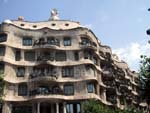
One hardly finds some symmetries, no constant supporting columns and not even a uniformly leveled roof line. In the interior of the building, there are two light trays at which the apartments are arranged around. The best is to look from above down to the light trays. During a sightseeing, one first takes the the lift to the second highest floor, where there is a completely furnished flat that is more than 100 years old to visit. 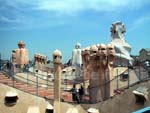
This flat viewing is really a task, as every detail is still recognizable, from a large bed up to the children's toys. One really feels like travelling back 100 years ago. One also needs much more time for the flat viewing as initially thought, as one repeatedely compares how everything was in former times, how the people lived and what remained the same. 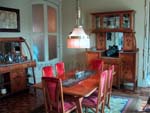
The highlight of the Casa Milà viewing is the roof deck with its bizarre chimneys; With so much exzentricity one starts to understand why Gaudí has one or two disputes with its building master Milà. On the roof, one of course enjoys a gorgeous view to Barcelona and the Passeig de Gràcia underneath. But what is much more imposing is the view to the roof deck itself, as such a roof does not exist in any other spot of the world. Observing these strange shapes, one starts to wonder if Gaudí was in his right mind; as known, there is just a thin line between brilliance and insanity. Moreover, there is a small Gaudí museum to visit that shows the biography of the famous artist with numerous small creations and exhibitions. One has to calculate 1-2 hours for visiting the Casa Milà, but it is worth it. Finally, since the year 1984, the Casa Milà is world cultural heritage! The entrance fee is with 6 € quite steep; then I ask myself why there are additionally 3 € to pay in order to get an electronical guide (such a device that reads some text after entering a number). Casa Battló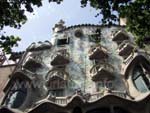
While the Casa Milà can be accessed up to the extravagant roof deck, the Casa Battló can be only viewed from outside. I mention this due to the reason that it is located on the way to the Casa Milà. By walking from the Plaša de Catalunya alongside the Passeig de Gràcia to the Cassa Milà, one comes across to the Casa Battló at the left roadside. This house was adapted to the modernisme style by the textile producer Battló in the years 1904-1906; the executing person was of course a certain Mister Gaudí. At first sight, the front reminds on a skeletton, as the balcony balustrades and the columns look like bones. Looking closer, the tiny mosaics of the house wall glistening at the sun give the front playful impression; Above at the roof line, a huge reptile seems to guard the house. Casa Amatller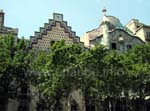
Can a modernisme building be overseen? Normaly, these buildings outstand so much from the usual cityscape that there are already visible at a far distance. But the Casa Amatller is frequently overseen - not because it is unimpressive and hidden, but because it is in the shadow of the Casa Battló. It is right at the left beside the Casa Battló and one first things that both are the same house. The Casa Amatller was built in the last yers of the 19th century. The great beauty of the house is only recognizable by looking at it from the roadside in front of it. The Casa Amatller has a wonderfully adorned pediment that reminds on a recious ornament of the neo-Gothic times. Palau de la Música CatalanaAt the northern part of the Via Laietana, approximately 400 m at the north of the subway station Jaume I, there is the Palau de la Música Catalana, a music palace that was built in the years 1905-1908 and also expanded in the meantimee. From the outside, the music palace appears as an "average" modernisme-building; but in the interior, a concert hall that is hard to beat in beauty is waiting. 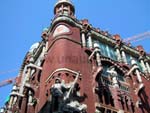
In the anterooms and stairs, there are busts of the famous barock, classic, and romantic components. The concert hall can be only visited with a guidance. There are guidances in English and Spanish language. I of course chose the english version; but I better should have chosen the Spanish version - not even Americans and English people understood the words of the female tour-guide. The concert hall is realy beautiful. The walls and the columns are adorned to no end: large surfaces are adorned with ornaments, balustrades are ornated with tendrillars and blossoms of stone and marble. But the most beautiful is the ceiling of the concert hall with a huge cupola arched to the inside. As beautiful as this Palau de la Música Catalana was, I could not enjoy this music palace, because as a tourist, one was ripped off here. 5 € entrance fee for a guidance in which one was pushed through in packs of hundred people and where nothing was understood. We were even not allowed to make some pictures; but we got the hint to buy some super expensive postcards in the shop. It is a pitty that in all cities there is always a place where as a tourist one is ripped off and one feels respectively bad afterwards. 
Copyright: Patrick Wagner, www.tourist-guide.biz |
||